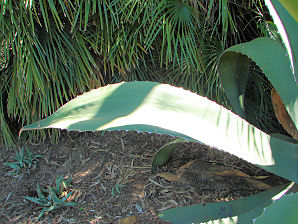Xeriscape Landscape Plants & Flowers
For The Arizona Desert Environment.
Pictures, Photos, Images, Descriptions, & Reviews.
Pulque Agave, Agave salmiana.
We Are Proud Of Our SafeSurf Rating!
Click On Any Of The Following Links By Amazon.Com
For Books, & Videos About Wildflowers Of Arizona & The Southwest USA. No Obligation!
 |
| Pulque Agave, Agave salmiana. Boyce Thompson Arboretum. Near Tucson, Arizona. September 19, 2006. |
|---|
 |  |
| Pulque Agave Leaf. Agave salmiana. | Pulque Agave Flower. Agave salmiana. |
|---|---|
 |  |
| Pulque Agave. At Xochit�catl And Cacaxtla. Ruins Puebla, Mexico. | Pulque Agave. At Zaachila Tomb. Ruins Oaxaca, Mexico. |
 |  |
| Click On This Photo To See The Xochit�catl And Cacaxtla. Ruins At Puebla, Mexico. | Click On This Photo To See The Zaachila Tomb & Ruins At Santa In�s del Monte Near Oaxaca, Mexico. |
|---|
Pulque Agave.
We wish to thank Wikipedia, the free encyclopedia for some of the information on this page. We share images and information with Wikipedia. This agave is a succulent recognizable by its thick, graceful, dark gray-green curving leaves with projecting spines and its massive stature, reaching 5 - 6 feet tall up to 10 - 12 feet wide. When the plant matures and blooms a tall candelabra inflorescence rises to over 20 feet bearing yellow flowers that attract many birds and bees. It produces many suckers which can lead to a large colony if the suckers are not removed. It takes full sun and is drought tolerant. The exact origins of this variety are unknown. It has a massive stature, urceolate form and shiny green leaves with short acuminate leaf tips. It is found in cultivation in the Tehuacan and Puebla regions, because Agave salmiana is considered to be "the" great wine making agave "maguey de pulque" and it was cultivated for this purpose for over 2000 years. Blooms only when the plant is 15 years old or more. The flower stalk is huge (15 to 40 feet), starting like an asparagus, but its flowers are inconspicuous. The plant then dies leaving suckers that grow into replacement plants. This massive and beautiful agave is from the Mexican states of Guanajuato, Oaxaca, and Puebla that forms a dense and very neat rosette of wide, dark green to gray green leaves. In Mexico, it is the premier source for the production of pulque (fermented juice of agave or maguey plants). In ancient Mexico, Ometotchtli, or Two Rabbit, was generally regarded as the supreme god of pulque, a "gift" from the gods to chase the sorrows of the human condition.
Quick Notes:
Height: 5 to 6 feet tall. It spreads to about 10 - 12 feet.
Flowers: A large stalk emerges from the center of the plant, it becomes 15 to 40 feet tall. Then green to yellow flowers emerge from the terminal end on a horizontal branching structure growing up to 6 feet in diameter. The flowers are green to pale yellow, up to 3 5/8 inches long, with perianth segments erect, up to 1 1/4 inch long, the ovary is shorter than the perianth.
Flowering Time: Phoenix Arizona, Mid March - April. It dies after blooming.
Leaves: The leaves symmetrical, a basal rosette, up to 6 feet long, nearly 12 inches wide, shiny green leaves with short acuminate leaf tips, curved or reflexed at the tip, margin toothed.
Found: Native Central Mexico, Usually used in cultivation for pulque.
Hardiness:
Soil pH requirements:
Sun Exposure:
Elevation: 0 - 5,800 Feet. In Mexico. Can take temperatures down to 18 �F.
Habitat: Native in sand, sandy loam, clay and other heavy soils. It needs good drainage and aeration. It is remarkably tolerant of alkali. Hardy to 18� F.
Miscellaneous: Maintenance: Low. Good xeriscape plant. Photos Taken; Boyce Thompson Arboretum, September 19, 2006. Again at Puebla and Oaxaca Mexico in 2005.
|
We Are Proud Of Our SafeSurf Rating!
Click On Any Of The Following Links By Amazon.Com
For Books, & Videos About Wildflowers Of Arizona & The Southwest USA. No Obligation!
| © 1966 - Present, Audrey, Eve, & George DeLange |
